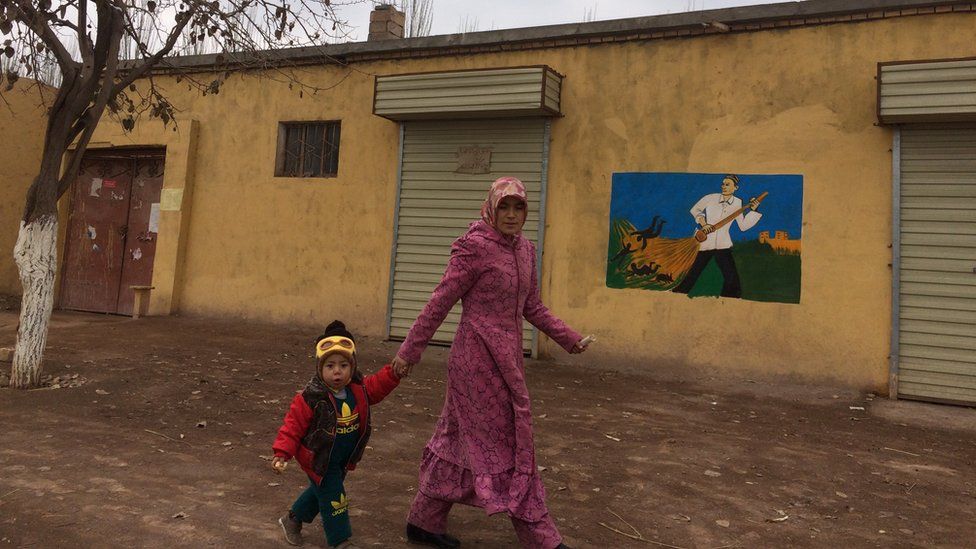The colourful propaganda of Xinjiang
- Published

China is in the midst of a crackdown on what it describes as "terrorism driven by religious extremism". The campaign is focused on the western province of Xinjiang, home to China's Uighur ethnic minority who are predominantly Muslim.
The government believes religion breeds terror and has been trying to control religious expression in the region by imposing rules on the Uighur community. Critics say it is exacerbating the terror problem.
The murals below were painted on the walls next to a mosque in the old Silk Road district of Kashgar where 90% of the population are Uighur.
They show what the Chinese government deems as acceptable and unacceptable behaviour. They are a striking example of Chinese propaganda and highlight the government's crude portrayal of ethnic relations in Xinjiang.
Inspirational posters are a fairly common sight in Chinese cities, advocating things like hard work and team spirit. It is not clear who painted these posters, but their presence implies they have some kind of official approval.
The government says some Uighurs are being radicalised by jihadist videos made in Pakistan and Afghanistan and accessed via the internet. Here, veiled Uighur women are downloading and sharing banned material with Uighur men.
Banned material can also be picked up by private satellite receivers, which are cheap in China but illegal without a permit.
In some places, the government has banned women from wearing veils.
The veiled Uighur woman on the left appears in stark contrast to the Uighur couple on the right who are wearing traditional clothes deemed acceptable by the government.
Throughout these murals, "bad" Uighurs are painted in black and grey while "good" law-abiding Uighurs are painted in bright colours and flanked by doves, a symbol of peace.
The government has doubled the policing budget in the province and jailed hundreds of Uighurs, but violent attacks have still continued.
Here, a Chinese cement roller crushes knife-wielding Uighurs, again painted in black.
"A mountain of knives and a sea of fire" is a Chinese proverb that describes a difficult and dangerous situation.
Many of the recent violent attacks in Xinjiang and beyond have involved knives.
Uighurs are now banned from buying knives in some parts of Xinjiang.
Beijing says terrorists must be chased down like rats in the street.
A similar image shows an axe with the National Emblem of the People's Republic of China crushing terrorists, again appearing in sinister black.
Armed security forces are a common sight on the streets of Xinjiang.
There are security check points on many roads and at the entrance of markets and shopping malls where Uighurs, especially young men, are stopped and checked.
The armed guards in this picture are flanked by peaceful doves.
In front of a Chinese flag, Uighurs read a Chinese book. The government believes Uighurs should be Chinese first and Muslim second.
The government has banned anyone under the age of 18 from entering a mosque.
The ban also applies to government officials and Communist Party members. Praying is strictly regulated in Xinjiang.
The government says Uighur children should attend school and not go to mosque.
This will keep them away from evil jihad as represented by the sinister Uighur in the left of this mural.
The picture on the left shows an imam marrying a Uighur couple in secret. This is against Chinese law.
Couples have to apply to the government for a marriage certificate.
The Uighur man on the right is holding up a book on Chinese marriage law. This is one more law imposed on the Uighur community by the government to control how they practice their religion.
The government has started a campaign called "Project Beauty".
Only older Uighur men are allowed to have beards while Uighur women are banned from wearing full veils.
Here, Uighur women are encouraged to show their face - to give their beauty to the world.
The Chinese government says it wants a harmonious society represented here by a woman in traditional Han - the ethnic majority in China - dress dancing happily with a Uighur woman.
Over the past 30 years there has been massive migration of Han Chinese to Xinjiang. This has created resentment among some Uighurs who feel their culture is being diluted.
- Published11 December 2014
- Published2 January 2015
- Published2 January 2015
- Published25 August 2023